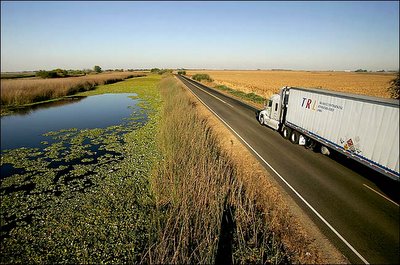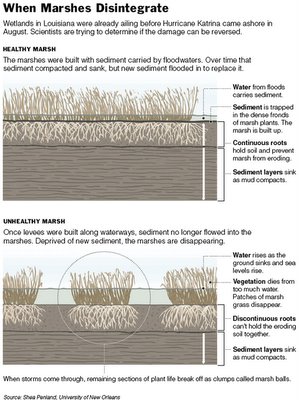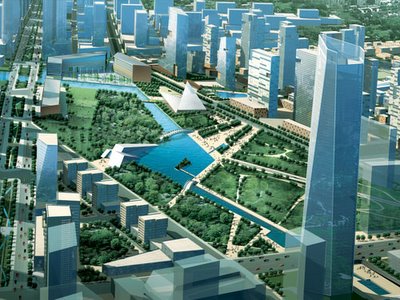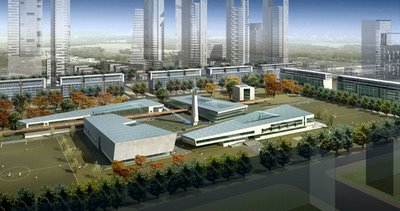At Random
A whole host of things to waste your lunch-break on:

<1> Photographer David Allee – whose image "Blue Lagoon" appears above – has a show coming up at Princeton.
Allee's photographs have studied, among other things, "the intrusive otherworldly effect of artificial light on man-made environments." As Metropolis further explains: "Working with a large-format Linhof Technikardan camera, he positions himself in front of apartment buildings, houses, and gardens that are bathed in the overflow of floodlights from sports and recreation facilities. Using shutter speeds of two to three minutes, Allee subjects his film to the kind of intense light that turns night into an unnatural day..."
<2> Some Finnish bunker archaeology and post-military landscape exploration – old bastions, train yards, abandoned towns, even a "sea fortress" – at Kimmo Nummela's Silent Wall.


This site includes a tour of the unsubtly named "toxic suburb of Alakiventie."
<3> Reading this put me in a strangely good mood: "the devastation from the Gulf Coast hurricanes is serving as a strong reminder that possible disasters could lay waste to cities and states across the country."
Wow. What kind of disasters?
"Officials in California worry about the collapse of aging levees in the delta of the Sacramento and San Joaquin Rivers, which might allow surging seawater to contaminate much of the state's drinking water supply. A major concern in Seattle is the seismic vulnerability of the Alaskan Way Viaduct, a busy elevated highway in such peril that weight and lane restrictions were imposed on buses and trucks. In Montana, Idaho and Wyoming, there is the recurring danger of a volcanic eruption at Yellowstone National Park, while in Florida, attention has turned anew to cleaning up Lake Okeechobee, which sends polluted water into nearby rivers during heavy rains and floods." Etc.

[Image: "A major earthquake near Stockton, Calif., where Highway 4 serves as a levee road, could be disasterous." David McNew/Getty Images].
But at least I'll be around to see what's next, I suppose, after civilization. After the human. I'll take notes, hiking through flooded cities like a modern-day Crusoe, crawling over concrete skeletons of collapsed highway flyovers, slowing dying of skin cancer. Grilling squirrel meat next to leaking power plants. My teeth falling out. I'll meet heavily armed women wearing animal fur bikinis and – wait a minute – what –

<4> "Small clouds of dark matter pass through Earth on a regular basis," the New Scientist reports. Those clouds "may be remnants of the first structures to form after the big bang."

[image: EurekAlert!].
These are structures made entirely of dark matter, however, and they look like "flattened spheres or cigars with diameters about 4000 times the distance between the Earth and Sun." And if that sounds nuts, remember that there could be "a million billion of them drift[ing] around the large dark matter halo that is thought to enclose our galaxy. Such a cloud may float through Earth every 10,000 years in an encounter lasting about 50 years... Their relatively wispy densities mean they could only nudge our planet out of its normal orbit by less than a millionth of a metre per second. Still, they may leave behind observable signatures."
Such as BLDGBLOG.
<5> Continuing BLDGBLOG's recent cosmology theme, here is a photograph of "star-forming pillars in a region known as W5 in the constellation Cassiopeia."

[Image: Spitzer Space Telescope].
"Nestled within the dusty pillars are hundreds of embryonic stars," says the New York Times, and yet these shining pillars "probably represent [only] the densest, most fecund remnants of a larger, cloud. [Note: that stray comma is the NYT's]. It is being eroded by radiation and winds of particles from a ferociously bright star just out of the top of the picture."
That photograph is also just an infrared version, taken from a section of this –

– which I'm sure you've seen. If not: it's the "Pillars of Creation" in the Eagle Nebula – but even they are fading! Everything ends.
<6> And, man, is this entry getting depressing: the marshes of Louisiana are dying.

[Image: "Dead oak trees signal a marsh in danger " Lori Waselchuk/NYTimes].
They're breaking up into so-called "marshballs" and other "marsh debris" – but why? "The questions are complicated, and the answers turn on a number of factors, including the region's geology, the ways people have engineered the flow of the Mississippi River, and the marsh-killing activities of the oil and gas industry."

[Illustration: Al Granberg, New York Times].
This comes less than a week after we read that "[r]estoring Louisiana's vanished wetlands, or even maintaining those that remain, will be impossible, according to an expert panel convened in 2004 by the National Academy of Sciences to consider a major proposal for wetlands restoration in the state. The panel says the time has come for state and local governments, businesses and citizens to start talking about which wetland areas can be preserved and which must be abandoned, a process it called 'managed retreat.'"

[Image: "A view of canal systems that link oil fields south of New Orleans." Lori Waselchuk/NYTimes].
But some people don't want to retreat – that would be un-American. Dan Walker, for instance, a geologist with the National Academy of Sciences, says that, quote, "If we don't draw this map, nature will."
And we can't let that happen.
For a more sustained look at the ins and outs of imperial hydrology see BLDGBLOG's first post on Hurricane Katrina, Chapter 1 in John McPhee's The Control of Nature – and, why not, Floating islands gone wild.
<7> BLDGBLOG has already reported on a new Russian utopia, but here's one in South Korea: New Songdo City.
"New Songdo, a free-enterprise zone where English will be the lingua franca, is often called the largest private real-estate development in the world. When completed in 2014," the New York Times says, "it is estimated that this $25 billion project will be home to 65,000 people and that 300,000 will work there. Amenities will include an aquarium, golf course, American-managed hospital and preparatory schools, a central park (like New York's), a system of canals (like Venice's) and pocket parks (like Savannah's), a self-described patchwork of elements gleaned from other cities."




[Images: Kohn Pederson Fox Associates].
A "patchwork of elements gleaned from other cities"? Yep – that means it will also look like every other city...
So it may not be utopia, but it is ubiquitous – and this is where it gets freaky: "A ubiquitous city is where all major information systems (residential, medical, business, governmental and the like) share data, and computers are built into the houses, streets and office buildings. New Songdo, located on a man-made island of nearly 1,500 acres off the Incheon coast about 40 miles from Seoul, is rising from the ground up as a U-city."
Thomas More meets Minority Report.
And for more images of New Songdo, stop by Metropolis. Also, see BLDGBLOG's Singapore Bio-utopia. (And more on this topic soon).
<8> I've hit the wall here; but I have about a hundred other links to add so I'll come back for those. Till then –

<1> Photographer David Allee – whose image "Blue Lagoon" appears above – has a show coming up at Princeton.
Allee's photographs have studied, among other things, "the intrusive otherworldly effect of artificial light on man-made environments." As Metropolis further explains: "Working with a large-format Linhof Technikardan camera, he positions himself in front of apartment buildings, houses, and gardens that are bathed in the overflow of floodlights from sports and recreation facilities. Using shutter speeds of two to three minutes, Allee subjects his film to the kind of intense light that turns night into an unnatural day..."
<2> Some Finnish bunker archaeology and post-military landscape exploration – old bastions, train yards, abandoned towns, even a "sea fortress" – at Kimmo Nummela's Silent Wall.


This site includes a tour of the unsubtly named "toxic suburb of Alakiventie."
<3> Reading this put me in a strangely good mood: "the devastation from the Gulf Coast hurricanes is serving as a strong reminder that possible disasters could lay waste to cities and states across the country."
Wow. What kind of disasters?
"Officials in California worry about the collapse of aging levees in the delta of the Sacramento and San Joaquin Rivers, which might allow surging seawater to contaminate much of the state's drinking water supply. A major concern in Seattle is the seismic vulnerability of the Alaskan Way Viaduct, a busy elevated highway in such peril that weight and lane restrictions were imposed on buses and trucks. In Montana, Idaho and Wyoming, there is the recurring danger of a volcanic eruption at Yellowstone National Park, while in Florida, attention has turned anew to cleaning up Lake Okeechobee, which sends polluted water into nearby rivers during heavy rains and floods." Etc.

[Image: "A major earthquake near Stockton, Calif., where Highway 4 serves as a levee road, could be disasterous." David McNew/Getty Images].
But at least I'll be around to see what's next, I suppose, after civilization. After the human. I'll take notes, hiking through flooded cities like a modern-day Crusoe, crawling over concrete skeletons of collapsed highway flyovers, slowing dying of skin cancer. Grilling squirrel meat next to leaking power plants. My teeth falling out. I'll meet heavily armed women wearing animal fur bikinis and – wait a minute – what –

<4> "Small clouds of dark matter pass through Earth on a regular basis," the New Scientist reports. Those clouds "may be remnants of the first structures to form after the big bang."

[image: EurekAlert!].
These are structures made entirely of dark matter, however, and they look like "flattened spheres or cigars with diameters about 4000 times the distance between the Earth and Sun." And if that sounds nuts, remember that there could be "a million billion of them drift[ing] around the large dark matter halo that is thought to enclose our galaxy. Such a cloud may float through Earth every 10,000 years in an encounter lasting about 50 years... Their relatively wispy densities mean they could only nudge our planet out of its normal orbit by less than a millionth of a metre per second. Still, they may leave behind observable signatures."
Such as BLDGBLOG.
<5> Continuing BLDGBLOG's recent cosmology theme, here is a photograph of "star-forming pillars in a region known as W5 in the constellation Cassiopeia."

[Image: Spitzer Space Telescope].
"Nestled within the dusty pillars are hundreds of embryonic stars," says the New York Times, and yet these shining pillars "probably represent [only] the densest, most fecund remnants of a larger, cloud. [Note: that stray comma is the NYT's]. It is being eroded by radiation and winds of particles from a ferociously bright star just out of the top of the picture."
That photograph is also just an infrared version, taken from a section of this –

– which I'm sure you've seen. If not: it's the "Pillars of Creation" in the Eagle Nebula – but even they are fading! Everything ends.
<6> And, man, is this entry getting depressing: the marshes of Louisiana are dying.

[Image: "Dead oak trees signal a marsh in danger " Lori Waselchuk/NYTimes].
They're breaking up into so-called "marshballs" and other "marsh debris" – but why? "The questions are complicated, and the answers turn on a number of factors, including the region's geology, the ways people have engineered the flow of the Mississippi River, and the marsh-killing activities of the oil and gas industry."

[Illustration: Al Granberg, New York Times].
This comes less than a week after we read that "[r]estoring Louisiana's vanished wetlands, or even maintaining those that remain, will be impossible, according to an expert panel convened in 2004 by the National Academy of Sciences to consider a major proposal for wetlands restoration in the state. The panel says the time has come for state and local governments, businesses and citizens to start talking about which wetland areas can be preserved and which must be abandoned, a process it called 'managed retreat.'"

[Image: "A view of canal systems that link oil fields south of New Orleans." Lori Waselchuk/NYTimes].
But some people don't want to retreat – that would be un-American. Dan Walker, for instance, a geologist with the National Academy of Sciences, says that, quote, "If we don't draw this map, nature will."
And we can't let that happen.
For a more sustained look at the ins and outs of imperial hydrology see BLDGBLOG's first post on Hurricane Katrina, Chapter 1 in John McPhee's The Control of Nature – and, why not, Floating islands gone wild.
<7> BLDGBLOG has already reported on a new Russian utopia, but here's one in South Korea: New Songdo City.
"New Songdo, a free-enterprise zone where English will be the lingua franca, is often called the largest private real-estate development in the world. When completed in 2014," the New York Times says, "it is estimated that this $25 billion project will be home to 65,000 people and that 300,000 will work there. Amenities will include an aquarium, golf course, American-managed hospital and preparatory schools, a central park (like New York's), a system of canals (like Venice's) and pocket parks (like Savannah's), a self-described patchwork of elements gleaned from other cities."




[Images: Kohn Pederson Fox Associates].
A "patchwork of elements gleaned from other cities"? Yep – that means it will also look like every other city...
So it may not be utopia, but it is ubiquitous – and this is where it gets freaky: "A ubiquitous city is where all major information systems (residential, medical, business, governmental and the like) share data, and computers are built into the houses, streets and office buildings. New Songdo, located on a man-made island of nearly 1,500 acres off the Incheon coast about 40 miles from Seoul, is rising from the ground up as a U-city."
Thomas More meets Minority Report.
And for more images of New Songdo, stop by Metropolis. Also, see BLDGBLOG's Singapore Bio-utopia. (And more on this topic soon).
<8> I've hit the wall here; but I have about a hundred other links to add so I'll come back for those. Till then –

Comments are moderated.
If it's not spam, it will appear here shortly!
Post a Comment